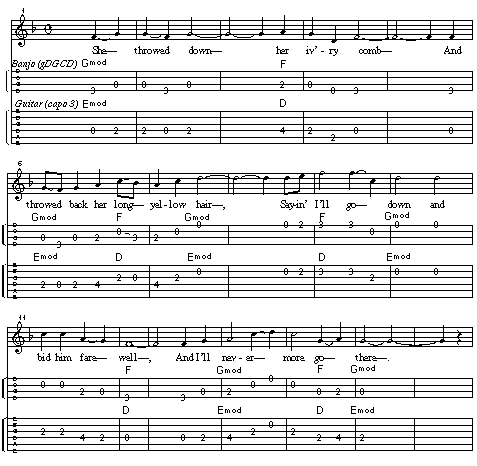Little Margaret- Lofgren/Lunsford 1997
[Adapted from the singing of Bascom Lamar Lunsford with additional text from Justus Begley by Lyle Lofgren, this is not a traditional version. However, it does improve some of Lunsford text (See: Little Margaret- Lunsford)and it has the music and TAB.]
Little Margaret
by Lyle Lofgren
(Originally published: Inside Bluegrass, April 1997)
Another ghostly golden oldie for you -- this one first appeared in print in England in the late seventeenth century, titled Lady Margaret and Sweet William, and was published by Child as ballad #74. The tune and most of the words of this American version are from Bascom Lamar Lunsford, an Asheville, NC, lawyer who collected songs, and sang them with 5string banjo accompaniment. Lunsford, who started the Asheville Folk Festival, was different from other folk music enthusiasts of his time (the 1930s) in that he didn't romanticize the folk into some kind of noble savages -- he presented mountain music with respect for the ones who had kept the tradition alive. Unfortunately, I mislaid the original recording years ago, so the words printed here represent the way I remember it, and I know I've interpolated some verses from the singing of Jean Ritchie (Viper, Kentucky) and Justus Begley (Hazard, Kentucky). Both of them use a very different tune, however: a bouncy one in a major key. The scale for Lunsford's ballad is what's sometimes called "Mountain Modal" or "Dorian" Mode. It's the scale you'd get by playing the white piano keys starting at D. The banjo tuning is transposed to G-modal: gDGCD (fifth to first) -- i.e., the open G-major tuning, except with the B string tuned up a half step to C. Many Appalachian banjo tunes use this scale, and I think of it as the original (pre-Monroe) High Lonesome Sound. Some examples are The Cuckoo (Clarence Ashley), Sugar Baby (Dock Boggs), and some versions of Shady Grove and The House Carpenter. Besides the strange open chord, the only other banjo chord used here is F-major (3-2-0-3 fingering, in this tuning). To play guitar with this, I use a chord I first learned by watching Doc Watson accompanying Ashley's Cuckoo. What I call Emod is fingered 0-2-2-2-0-0 (low to high). The other chord is D major. Of course, to play along with the tune as it's written, you have to capo the guitar up three frets so you're also playing in G modal.
Lyle and I decided this month to give you both the guitar and banjo tabs. The banjo part is on the middle staff, with the four lines, written in gDGCD tuning. We've written out the basic melody; you'll have to decide how to frail it. The tab below that is for guitar; capo up three frets to play it.]

Complete Lyrics:
"Little Margaret, sitting at her high hall door,
Combing back her long, yellow hair,
When she saw Sweet William and his new-made bride
Riding from the church so near.
She throwed down her iv'ry comb,
Throwed back her long yellow hair,
Saying, "I'll go down and bid him farewell,
And nevermore go there."
It's day being gone and night coming on,
When most all men were asleep,
Little Margaret appeared all dressed in white,
A-standing at their bed-feet.
"How do you like your pillow," she asked him,
"How do you like your sheet?
How do you like that gay young lady
That's lying in your arms asleep?"
"Very well do I like my pillow," he answered,
"Much better do I like my sheet,
But best of all is that fair young maid
That's standing at my bed-feet."
Then night being gone and day coming on,
When most all men were awake,
Sweet William told how he's troubled to his soul
By a dream that he dreamed last night.
"Such dreams, such dreams, I do not like,
Such dreams, they are no good;
I dreamed my floor was covered with gore,
And my true love a-swimming in blood."
So he called his serving man to go
And saddle the dapple roan,
And he rode till he come to Lady Margaret's house,
He rode to her house alone.
"Is Lady Margaret in her room,
Or is she in the hall?"
"No, Little Margaret's in her coal-black coffin,
With her pale face turned to the wall."
Once he kissed her lily-white hand,
And twice he kissed her cheek,
Three times he kissed her cold corpsy lips
And fell in her arms asleep.
--------------------------------------------------------------------------------
Bibliography
As noted, this is #74 in Child's The English and Scottish Popular Ballads, where it goes by the title "Fair Margaret and Sweet William." It seems to have been known as early as 1611, when Beaumont and Fletcher included these lines in the play The Knight of the Burning Pestle:
When it was grown to dark midnight
And all were fast asleep,
In came Margaret's grimly ghost
And stood at William's feet
Child knew only three texts of the piece, but Bronson listed 79 tunes, from England, Scotland, all parts of the U.S. east of the Mississippi, and Newfoundland.
Although it was commonly found in the early part of this century, I know of few recent collections.